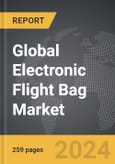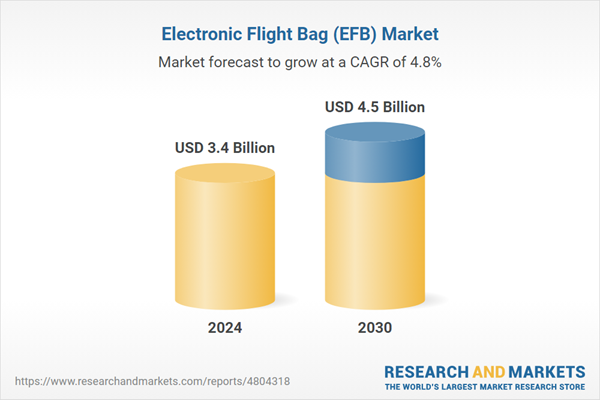The global market for Electronic Flight Bag (EFB) was valued at US$3.4 Billion in 2024 and is projected to reach US$4.5 Billion by 2030, growing at a CAGR of 4.8% from 2024 to 2030. This comprehensive report provides an in-depth analysis of market trends, drivers, and forecasts, helping you make informed business decisions. The report includes the most recent global tariff developments and how they impact the Electronic Flight Bag (EFB) market.
Segments: Type (Portable, Installed); Platform (Commercial, Military); Component (Software, Hardware).
Geographic Regions/Countries: World; United States; Canada; Japan; China; Europe (France; Germany; Italy; United Kingdom; and Rest of Europe); Asia-Pacific; Rest of World.
The analysts continuously track trade developments worldwide, drawing insights from leading global economists and over 200 industry and policy institutions, including think tanks, trade organizations, and national economic advisory bodies. This intelligence is integrated into forecasting models to provide timely, data-driven analysis of emerging risks and opportunities.
Global Electronic Flight Bag (EFB) Market - Key Trends and Drivers Summarized
How Is the Electronic Flight Bag (EFB) Transforming Aviation?
The Electronic Flight Bag (EFB) is revolutionizing aviation by replacing traditional pilot briefcases full of paper charts, manuals, and documents with digital solutions. EFBs, typically composed of software and hardware, enhance flight management by providing pilots with easier access to navigation charts, airport diagrams, operating manuals, and real-time weather reports. This shift not only reduces the weight of physical documents that aircraft must carry - thereby saving fuel - but also increases the efficiency and safety of flight operations. EFBs streamline the updating process for navigational data and ensure that pilots always have the most current information at their fingertips. They support better decision-making in the cockpit with tools for performance calculations and critical flight information, essential in today’s complex and dynamic aviation environment.What Innovations Are Enhancing the Functionality of Electronic Flight Bags?
Innovations in EFB technology are continually enhancing their functionality, making them more integrated and user-friendly. Modern EFBs leverage cloud computing to ensure that all flight documentation and data are up-to-date and synchronized across devices. The integration of real-time data analytics has also become a standard feature, providing pilots with live weather updates, potential turbulence reports, and optimal flight paths. Additionally, touchscreen interfaces and customizable applications enhance user interaction, allowing pilots to access information more quickly and intuitively. There is also a significant push towards incorporating artificial intelligence to automate routine tasks and predict maintenance needs, further enhancing operational efficiency. With these advancements, EFBs are becoming an indispensable tool in the cockpit, ensuring that flight operations are as smooth and safe as possible.How Do Electronic Flight Bags Impact Environmental Sustainability?
Electronic Flight Bags contribute significantly to environmental sustainability in aviation by reducing the need for paper, thus decreasing waste and the environmental impact associated with paper production, printing, and disposal. By digitizing flight materials, EFBs also lower the weight carried by aircraft, leading to lower fuel consumption and reduced greenhouse gas emissions. This reduction is critical in an industry under increasing pressure to meet global environmental targets and reduce its carbon footprint. Furthermore, EFBs can optimize flight paths and improve flight efficiency, which not only saves time but further reduces fuel usage and emissions. As airlines strive to become more sustainable, the adoption of EFBs plays a crucial role in their environmental strategies.What Trends Are Driving Growth in the Electronic Flight Bag Market?
The growth of the electronic flight bag market is driven by several trends, including the ongoing digital transformation in aviation, regulatory support for paperless operations, and increasing emphasis on flight safety and efficiency. As airlines continue to seek cost-effective solutions to enhance operational efficiency, EFBs are being recognized as a vital technology in reducing operational costs and improving compliance with aviation standards. Regulatory bodies worldwide are encouraging the adoption of EFBs by streamlining approval processes and setting guidelines that support their use. Additionally, as global air traffic continues to grow, the need for improved navigational accuracy and efficiency becomes even more critical, further bolstering the demand for advanced EFB solutions. These trends, combined with the aviation industry's push towards greater sustainability and safety, ensure a robust and expanding market for electronic flight bags.Report Scope
The report analyzes the Electronic Flight Bag (EFB) market, presented in terms of units. The analysis covers the key segments and geographic regions outlined below.Segments: Type (Portable, Installed); Platform (Commercial, Military); Component (Software, Hardware).
Geographic Regions/Countries: World; United States; Canada; Japan; China; Europe (France; Germany; Italy; United Kingdom; and Rest of Europe); Asia-Pacific; Rest of World.
Key Insights:
- Market Growth: Understand the significant growth trajectory of the Portable EFB segment, which is expected to reach US$3.2 Billion by 2030 with a CAGR of a 5.5%. The Installed EFB segment is also set to grow at 3.5% CAGR over the analysis period.
- Regional Analysis: Gain insights into the U.S. market, valued at $934.7 Million in 2024, and China, forecasted to grow at an impressive 4.4% CAGR to reach $704.3 Million by 2030. Discover growth trends in other key regions, including Japan, Canada, Germany, and the Asia-Pacific.
Why You Should Buy This Report:
- Detailed Market Analysis: Access a thorough analysis of the Global Electronic Flight Bag (EFB) Market, covering all major geographic regions and market segments.
- Competitive Insights: Get an overview of the competitive landscape, including the market presence of major players across different geographies.
- Future Trends and Drivers: Understand the key trends and drivers shaping the future of the Global Electronic Flight Bag (EFB) Market.
- Actionable Insights: Benefit from actionable insights that can help you identify new revenue opportunities and make strategic business decisions.
Key Questions Answered:
- How is the Global Electronic Flight Bag (EFB) Market expected to evolve by 2030?
- What are the main drivers and restraints affecting the market?
- Which market segments will grow the most over the forecast period?
- How will market shares for different regions and segments change by 2030?
- Who are the leading players in the market, and what are their prospects?
Report Features:
- Comprehensive Market Data: Independent analysis of annual sales and market forecasts in US$ Million from 2024 to 2030.
- In-Depth Regional Analysis: Detailed insights into key markets, including the U.S., China, Japan, Canada, Europe, Asia-Pacific, Latin America, Middle East, and Africa.
- Company Profiles: Coverage of players such as Airbus Group SE, Astronautics Corporation of America, Dac International, Inc., Esterline Technologies Corporation, Flightman Ltd. and more.
- Complimentary Updates: Receive free report updates for one year to keep you informed of the latest market developments.
Some of the 14 companies featured in this Electronic Flight Bag (EFB) market report include:
- Airbus Group SE
- Astronautics Corporation of America
- Dac International, Inc.
- Esterline Technologies Corporation
- Flightman Ltd.
- Jeppesen Sanderson, Inc.
- L-3 Communications Holdings, Inc.
- Lufthansa Systems GmbH & Co. KG
- NAVTech Inc.
- Rockwell Collins, Inc.
- Teledyne Controls LLC.
- UTC Aerospace Systems
Tariff Impact Analysis: Key Insights for 2025
Global tariff negotiations across 180+ countries are reshaping supply chains, costs, and competitiveness. This report reflects the latest developments as of April 2025 and incorporates forward-looking insights into the market outlook.The analysts continuously track trade developments worldwide, drawing insights from leading global economists and over 200 industry and policy institutions, including think tanks, trade organizations, and national economic advisory bodies. This intelligence is integrated into forecasting models to provide timely, data-driven analysis of emerging risks and opportunities.
What’s Included in This Edition:
- Tariff-adjusted market forecasts by region and segment
- Analysis of cost and supply chain implications by sourcing and trade exposure
- Strategic insights into geographic shifts
Buyers receive a free July 2025 update with:
- Finalized tariff impacts and new trade agreement effects
- Updated projections reflecting global sourcing and cost shifts
- Expanded country-specific coverage across the industry
Table of Contents
I. METHODOLOGYII. EXECUTIVE SUMMARY2. FOCUS ON SELECT PLAYERSIII. MARKET ANALYSISIV. COMPETITION
1. MARKET OVERVIEW
3. MARKET TRENDS & DRIVERS
4. GLOBAL MARKET PERSPECTIVE
UNITED STATES
CANADA
JAPAN
CHINA
EUROPE
FRANCE
GERMANY
ITALY
UNITED KINGDOM
REST OF EUROPE
ASIA-PACIFIC
REST OF WORLD
Companies Mentioned (Partial List)
A selection of companies mentioned in this report includes, but is not limited to:
- Airbus Group SE
- Astronautics Corporation of America
- Dac International, Inc.
- Esterline Technologies Corporation
- Flightman Ltd.
- Jeppesen Sanderson, Inc.
- L-3 Communications Holdings, Inc.
- Lufthansa Systems GmbH & Co. KG
- NAVTech Inc.
- Rockwell Collins, Inc.
- Teledyne Controls LLC.
- UTC Aerospace Systems
Table Information
| Report Attribute | Details |
|---|---|
| No. of Pages | 259 |
| Published | April 2025 |
| Forecast Period | 2024 - 2030 |
| Estimated Market Value ( USD | $ 3.4 Billion |
| Forecasted Market Value ( USD | $ 4.5 Billion |
| Compound Annual Growth Rate | 4.8% |
| Regions Covered | Global |









